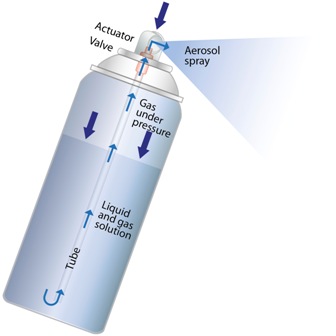 Aerosol cans are recyclable. However, they should only be placed in curbside recycling bins under three conditions:
Aerosol cans are recyclable. However, they should only be placed in curbside recycling bins under three conditions:
1) The can contents were non-hazardous, non-flammable materials like cooking spray, whipped cream, spray cheese, shaving cream or gel, hair mousse, etc.,
and
2) The can is empty of product,
and
3) The can has been depressurized of residual propellant. This can be accomplished by holding the can upside down and depressing the valve trigger after product dispensing slows and stops until no more hissing sound can be heard.

Anatomy of an aerosol can (image credit: European Aerosol Federation)
Why are these steps important? It's key for sanitation worker safety to keep hazardous and highly flammable materials out of the municipal mixed recycling stream. Aerosols containing either excess product (and thus, excess propellant) or just propellant alone, can explode if the can is ruptured. Modern propellants are usually flammable liquefied gasses like butane and propane under high pressure (see side-bar about CFCs - ozone destroying propellants no longer in use). Improperly emptied aerosols are a frequent fire-starter aboard garbage and recycling trucks where the truck's compaction can rupture the can, and in recycling centers' bailing equipment.
Recycling "Hard-to-Recycle" Aerosols
Any aerosol can that contains or used to contain a household hazardous waste or flammable product can be called "hard to recycle" because they
should not go in your curbside bins (either recycling or trash). These would include spray paints and other aerosol surface coatings, cleaning products, bug repellant and insecticide, butane refills, flammable hair spray or body spray, fabric protectants, etc.
We are lucky to have a Kane County-based partner company dedicated to recycling aerosols called Flat Can Recycling.

If you drop an aerosol item off at our Fabyan Recycling Center, at one of our events, or at any other
Flat Can collection point, here's all the steps it will go through:
- Drainage of residual contents (all contents, including household hazardous wastes, are disposed of properly and in accordance with state and federal regulations)
- Depressurization (to eliminate explosion risks)
- Disassembly into component parts (while the bulk of an aerosol can is metal, the cap, valve and dip tube are all various types of plastic)
- Transportation to appropriate recyclers or markets (plastics and metals are separated and transported separately to different end markets)
The steps described above require time and effort, which is why Flat Can charges $1.00 per aerosol item for recycling. This is a relatively low cost for the peace of mind that you will not inadvertently be responsible for a fire on a recycling truck or in a facility!
There are a few other options for these hard to recycle cans: